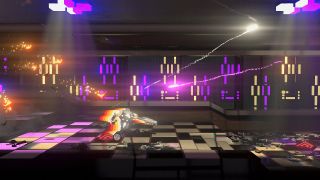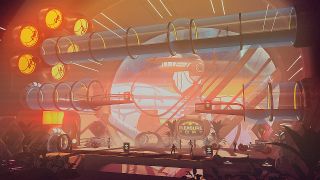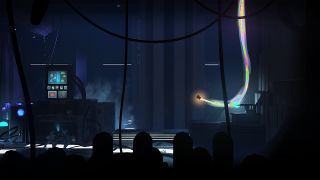GamesRadar+ Verdict
Headlander has a few rough spots, but its 70s retro/sci-fi aesthetic and head-swapping gameplay are out of this world.
Pros
- +
That aesthetic
- +
Interesting twist on the 'metroidvania' formula
- +
Brisk, snappy pace
Cons
- -
Combat is finicky
- -
Switching heads and backtracking can get a bit tedious
Why you can trust GamesRadar+
Headlander is more than just a pretty face. Well, it's mostly face - in Double Fine's latest, you're only a floating head, after all - but it's also more than slick pastiche of 70s-inspired sci-fi tropes, shag carpeting, and Yes album covers. Headlander is a clever twist on the sidescrolling adventure; a game where you have to behead robotic guards, patrolling Roombas, and cybernetic puppies in order to solve situational puzzles and overcome myriad obstacles. And it's the best thing Double Fine's made in years.
Set in a far-flung future where lava lamps clearly never went out of style, Headlander puts you in the noggin of the last surviving members of the human race. An event known as the 'ever-war' has killed off most of humanity; the rest have had their personalities downloaded into robot bodies. You're awoken from cryo-sleep, a living head inside of a rocket-powered space helmet, and a voice belonging to a man named Earl beckons you to head to a nearby city floating in the stars, where a supercomputer named Methuselah gives his robotic citizens the perfect world to live in, but rules over them with an iron fist. As you explore, you'll begin to piece together clues and discover your role in the universe, all while trying to rescue humanity from their utopian prison.

The narrative itself is a bit lean, but the real joy comes from navigating through this wildly inventive retro-future world, reminiscent of classic sci-fi movies from 2001: A Space Odyssey to Logan's Run and everything in between. Everything in the environment has a sense of place, telling its story through the aesthetic of the different rooms you'll explore. One robot you'll control starts up by inserting a cassette tape into his chest with a satisfying thunk; another one you'll find is a helper robot named MAPPY, who is obsessively worried and creepishly cheery about making sure you know where you are at all times. All of this is set in a world filled with orb-shaped fixtures, fiberglass, wall-sized computers covered in blinking lights, and a distinctly 70s-flavored color pallette. The story might not wow all the time, but the atmosphere is positively groovy, baby, and it's an absolute joy to get lost in.
Which is good, because you'll spend a lot of time wandering back and forth trying to figure out where to go next. As a sidescrolling action-adventure game with a focus on exploration, (more colloquially known as a 'metroidvania'), you're required to backtrack through places you've already visited in order to use new powers and skillsets to solve puzzles and find previously inaccessible secrets. In Headlander, you'll do most of this through the various robot bodies you'll come across. Your helmet is equipped with a vacuum, and you can suck the head off any android you see and attach your own helmet to its neck (hilariously referred to in-game as 'headlanding'), effectively possessing it. This is useful for a number of reasons, whether you need to open up security doors by possessing a security card with a matching color or better; enter tiny doors only accessible by robot puppy; shoot at swarms of incoming enemy robot patrols, and much more. Interestingly, you can't jump when you've headlanded onto a body. At first it feels restrictive, but eventually you'll come to see how figuring out the proper path to the next area is a fundamental part of its design, and after a while, you'll warm right up to Headlander's strange juggling act.

It's a fascinating system, and one that finds new ways to build off itself as you progress. At first, it's a bit easy, as enemy guards don't pose much of a threat so you can just fly past them and yoink their heads off. Later on, though, you have to be much more agile, headlanding onto robots, getting a few shots off, then bailing for another body once it gets damaged too much. Unfortunately, aiming your laser fire with the analog stick is always a pretty finicky process, and sometimes it feels like it's not up to the task, especially near the end when you're being bombarded by laser blasts bouncing off the walls at you from every angle. Eventually your headlanded bodies will be able to make use of a combat shield, activate an ability to slow time (which gives the whole screen a fantastic, desaturated VHS look), turn themselves into automatic sentries, and more, which definitely helps to take the edge off. You'll also unlock new abilities for your helmet, like a boost-dash and a reflective shield, which allows your cranium to access areas it couldn't reach before - and many of these places offer useful health and energy upgrades, so the rewards for taking the time to go back and seek them out are usually worth it.
Most of the time, Headlander keeps a brisk pace; movement is incredibly speedy, combat's usually over pretty quickly, and backtracking is mostly confined to distinct areas (and there's a pretty decent warp system should you need to go back to old locations for any reason). There are times when the headlanding and robot swapping gets a bit tedious, though, especially when you finally get a handle on a particular area's maze of color-coordinated security doors, and have to wander back through Headlander's corridors to find a security patrol that can get you through.

There's a particularly headache-inducing part about halfway through where you have to navigate through a series of shafts to unlock a bunch of elevators. This section comes close to grinding everything to a halt, as you first have to maneuver up and down and through side passages to activate the elevators, then actually go back to the top to use them - and then to actually use them, you have to detach from your robot, headland onto the elevator, slowly move it up or down, detach, headland back onto the robot, and keep going. It's the weakest point of an otherwise fun and snappy game, and Headlander quickly rebounds by having the very best part come right after it. (Seriously, wait until you get to Grid Clash. It's awesome.)
Like many of Double Fine's games, Headlander is a bit rough around the edges in a few places, but it's probably the studio's best marriage of concept and quality of content since Psychonauts. It's an inventive sidescroller that hits way more than it misses; a psychedelic sci-fi head trip well worth taking.
This game was reviewed on PS4.
More info
| Genre | Platformer |
Harry Potter director thinks Oppenheimer star Cillian Murphy would be a perfect Voldemort in new TV show
Solo Leveling season 2 just introduced a mysterious character who is likely to have a big impact on the anime's future

Monster Hunter Wilds devs are "looking at" lowering the recommended GPU specs, but a free hardware benchmark tool isn't coming just yet
Most Popular

